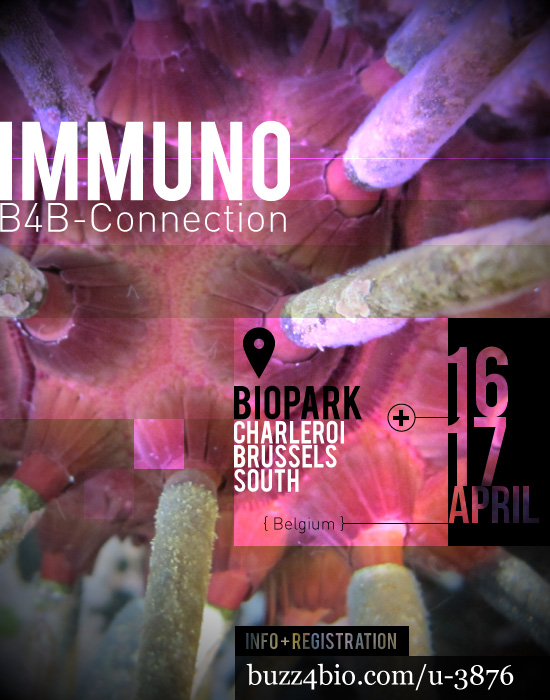Apoptosis is the process of programmed cell death. Upon induction of apoptotic processes, cell undergo characteristic morphological changes (blebbing, cell shrinkage, nuclear fragmentation, chromatin condensation, chromosomal DNA fragmentation) and finally die.
Apoptosis has to be clearly separated from necrotic processes, which occur due to cellular injury thus being a kind of traumatic cell death. Apoptosis on the other side is a process which is necessary during the life cycle of organisms.
In a human adult, 50 – 70 billion cells die per day due to apoptosis.
Defective apoptotic processes have been linked to a number of diseases such as cancer (insufficient apoptosis) and atrophy (excessive apoptosis).
Two pathways lead to apoptosis.
- Positive induction by binding of a ligand to a membrane receptor (TNF receptor family) of the target cell
- Negative induction by the loss of surpressing signal
Ultimately, both pathways lead to activation of cysteine proteases and further to proteolytic degradation of a number of proteins which are necessary for cell viability.
Positive regulation
A large number of ligands of TNF family receptors positively regulate apoptosis.
- TNF-alpha ( human, murine , rat), also called “Tumor necrosis factor”: one of the most potent apoptotic inducers binding to either TNF receptor 1 or 2.
- CD30 ligand: expressed in activated CD4 and CD8 T cells and binds to CD30, a member of the TNF receptor family)
- Fas ligand: binds to Fas Receptor, triggers apoptosis in Fas-bearing cells
- LIGHT : signals through the herpes virus entry mediator type A receptor (HVEM, TNFRSF14) or the Lymphotoxin ß receptor (LTβR) and actives NFκB, to co-stimulate the activation of lymphocytes and to induce apoptosis in certain human tumor cells.
- TRAIL (human, murine): a cytotoxic protein, which activates rapid apoptosis in tumor cells, but not in normal cells. TRAIL induced apoptosis is achieved through binding to two death-signaling receptors, DR4 and DR5 (both belonging to the TNF receptor family).
- TWEAK: expressed in a variety of tissues, including the adult heart, pancreas, skeletal muscle, small intestine, spleen and peripheral blood lymphocytes. TWEAK has the ability to induce NFkB activation and chemokine secretion, and to exert an apoptotic activity in certain cells, such as HT-29 human adenocarcinoma cells when cultured in the presence of IFN-γ.
Negative regulation
Another set of factors is able to negatively regulate apoptosis usually through binding to members of the TNF receptor family.
- APRIL : a member of the TNF superfamily, expressed in monocytes, macrophages, certain transformed cell lines, certain cancers of the colon, and lymphoid tissues. It can, for example, protect myeloma cells from apoptosis.
- BAFF : acts in a similar way to APRIL.
- CD27 ligand: expressed on activated T and B lymphocytes as well as NK cells. CD27L and its receptor (CD27) regulate the immune response by promoting T-cell expansion and differentiation, as well as NK enhancement. CD27 ligand can prevent Fas dependent apoptosis in CD8 T cells.
- BCMA : stimulates IgM production in peripheral blood B cells and thus increases survival of B cells.
- OPG (Osteoprotegerin): acts as a decoy receptor for RANKL. Binding of soluble OPG to sRANKL inhibits osteoclastogenesis by interrupting the signaling between stromal cells and osteoclastic progenitor cells, finally leading to excess accumulation of bone and cartilage.
- OX40 : is expressed on antigen presenting cells (APCs), such as dendritic cells and activated B-cells, and also on various other cells such as vascular endothelial cells, mast cells, and natural killer cells and signals through the OX40 receptor. It enhances cell proliferation and survival, and increases expression of RANTES, IL-2, IL-3, and IFNγ.
- TACI : expressed in the small intestine, spleen, thymus, peripheral blood leukocytes, activated T cells, and resting B cells. TACI binds to both APRIL and BAFF and can stimulate the activation of transcription factors; NF-kappaB, AP-1, and mediates calcineurin dependent activation of NF-AT (nuclear-factor of activated T cells).
Any doubts about the best factors for your research?
Finding the tools optimally suited to your needs helps to boost research. Some expert advice in identifying and using the best factors may be welcome!
[contact-form to=’ali.el.baya@tebu-bio.com’ subject=’Cytokines and growth factors…’][contact-field label=’Nom’ type=’name’ required=’1’/][contact-field label=’Email’ type=’email’ required=’1’/][contact-field label=’Commentaire’ type=’textarea’ required=’1’/][/contact-form]



